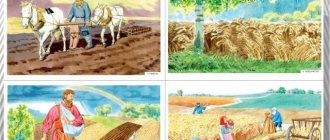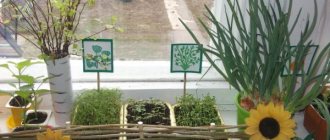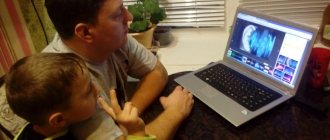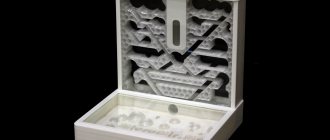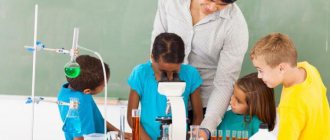“Tales of Pushkin” project on fiction (preparatory group)
Project
"Tales of A. S. Pushkin"
in the preparatory group
teacher: Gorbushina T.B.
Relevance of the project. Fiction has always influenced the mental and aesthetic development of a child. Its role in the development of speech of a preschooler is great. Therefore, when we introduce a child to any type of creative activity, it has a positive effect on his mastering another type of creativity, enriches the experience, and evokes deeper feelings and emotions. One of the most brilliant creators of artistic images that children can understand is Alexander Sergeevich Pushkin. The work of A. S. Pushkin opens and explains to the child the life of society and nature, the world of human feelings and relationships. Children develop thinking and imagination, and their emotions become enriched. Its educational, cognitive and aesthetic significance is enormous, since by expanding the child’s knowledge of the world around him, the fairy tales and poems of A. S. Pushkin influence the personality of children and develop the ability to subtly sense the form and rhythm of their native language. The melodiousness, rhythm, brevity, expressiveness, and musicality of his poems always resonate in the soul of both an adult and a child. The creativity of A. S. Pushkin helps the child develop a high level of speech culture, promotes the development of figurative speech, and the perception of various subjects. Enriching and activating the vocabulary is aimed at understanding the semantic richness of a word and helps to emphasize its imagery. The task of adults is to introduce children to the poet’s work as early as possible and to make his poems and fairy tales part of the child’s inner world. Project problem: • Children show interest in fairy tales, but it is necessary to diversify preschoolers’ ideas about different types of fairy tales. • Insufficiently high level of reading interest and reading culture of children. Problematic questions: • Do you like fairy tales and why? • What benefits do they bring? • Are fairy tales necessary in life? • Who writes fairy tales? Goal: Introducing children to the riches of Russian fiction using the example of the work of A. S. Pushkin. Objectives: Educational: • To introduce the life and work of A. S. Pushkin. • Teach to understand the moral of each fairy tale, introduce human vices and virtues. • To develop in children a sustainable interest in reading, the ability to listen and understand literary text. Developmental: • To form a high cognitive interest of children and parents in the work of the great Russian poet. • Establish rules for communicating with books and selecting literature for the book corner. • Encourage creative expression in creative games based on the plots of works, dramatizations, dramatizations, expressive reading, drawing and other activities. Educational: • To cultivate a sense of beauty through the works of the poet. • Foster patriotic feelings and pride in Russia. Project participants: teachers, children, parents, music director. Implementation time frame: 1 month Expected result: • Acquaintance with the life and work of A. S. Pushkin. • Understanding the moral of each tale, familiarity with human vices and virtues. • Formation in children of a sustainable interest in reading, the ability to listen and understand literary text. Educational area: cognitive development, speech development, artistic and aesthetic development. Project type: informational, educational, creative. Type of project: creative. Project methods: • Observations: group, individual; • Visual: illustrations, paintings; • Verbal: conversations, reading fiction. Form of implementation: play activities, conversations, reading fiction, exhibition of books, children's drawings made in different techniques (drawing, applique, applique using various materials on the themes of the works of A. S. Pushkin. Types of work: • Selection of fiction. • Selection of illustrative material. • Organized and unorganized activities. • Joint and independent activities. • Creation of a corner on the topic of the project. • Presentation of the project. Preparatory stage. • Questioning parents and asking children about what books they read at home; whether there are works in the home library A. S. Pushkin. • Discussion of the goals and objectives of the project, clarification of the possibilities, means necessary for the implementation of the project. • Drawing up a work plan. • Selection of methodological, fiction, illustrative, musical material on the topic of the project. • Selection of material for visual and productive children's activities. Main stage. Organized activities. Conversations with children: • What fairy tales of A. S. Pushkin do you know? • What are fairy tales for? • What kinds of fairy tales are there? • My attitude towards fairy tales. • What is your favorite fairy tale? Why? • What do fairy tales teach? • Why do animals talk in fairy tales? Fiction. Reading: • “Lukomorye has a green oak tree...”. • “The Tale of the Dead Princess and the Seven Knights.” • "The Tale of Tsar Saltan". • "The Tale of the Fisherman and the Fish". • “The Tale of the Golden Cockerel.” • “The Tale of the Pope and his worker Balda” Memorization: • poems by A. S. Pushkin: “Winter Sorceress” “The sky was already breathing in autumn...” Excerpt from the poem “Winter Evening” Lessons Timeframe 1. “Alexander Sergeevich Pushkin - the great Russian storyteller". Goal: To expand and deepen children’s knowledge about the great Russian poet A. S. Pushkin and his work for children; introducing children to cultural universal values and the richness of their native language. October 2. “Reading excerpts from fairy tales by A.S. Pushkin.” Goal: Formation of interest and positive attitude towards the work of A. S. Pushkin. October 3. Modeling “Goldfish”. Purpose: To consolidate children's knowledge of oval shapes, sculpting techniques: rolling with straight movements of the palm, sculpting with fingers. Reinforce the techniques of rolling plasticine with straight and circular movements, teach how to depict fish scales using the method of rolling plasticine in circular movements and flattening. Teach children to think logically. Make children want to admire the beauty of fish. Cultivate accuracy in work. October 4. “Journey through Pushkin’s fairy tales.” Goal: To teach children to understand the beauty and power of the Russian language, to learn to use figurative expressions, to speak beautifully and correctly. To consolidate knowledge about the work of A. S. Pushkin, his poems and fairy tales. October Game - fantasy “If I caught a goldfish.” Reading competition (excerpts from the works of A. S. Pushkin). Game - dramatization “Near Lukomorye there is a green oak tree...” Game “Reverse tale” Artistic and productive activity Drawing “There, on unknown paths...”. Modeling “Inhabitants of A. S. Pushkin’s fairy tales.” Collective applique “Goldfish”. Exhibition of drawings “My favorite fairy tale” • Exhibition of children's works “Fairy tales of A. S. Pushkin in pictures”. Creation of illustrations for fairy tales by A. S. Pushkin D/i: • “Find an object from fairy tales • by A. S. Pushkin” • “Learn a fairy tale from an illustration” • “Compose a fairy tale” • “Find the differences” Exhibition of books with works by A. S. Pushkin. Games: • “Say the word” • “Who is he?” » October Working with parents. • Replenishment and selection of material on the topic for the book corner. • Collaborative work of parents and children to create the album “Ah! What a delight these tales are! » • Motivational support – show your own interest in the topic of the project being implemented. • Consultation for parents “Tales of A. S. Pushkin in the life of a child” Final stage. • Analysis of the results of the work done (report and photo report on the implementation of the project)
Conclusion: This project must solve the following tasks. • Conversations, discussions, participation in various activities on an equal basis with adults - broaden the horizons of pupils, unite the children's team. • To make children want to read fairy tales, be kinder, and believe in magic. • Connect parents of students to project activities, involve them in live and direct participation at all stages of the project. Literature: • A. S. Pushkin. "Poems and fairy tales." Ed. Children's literature • I. A. Lykova “Visual activities in kindergarten”; Publishing house "Color World".
MAGAZINE Preschooler.RF
Creative project “Tales of A.S. Pushkin"Municipal state preschool educational institution of the city of Novosibirsk “Kindergarten No. 398 “Swallow” of a combined type”
Teacher of the 1st category: Sysenko T.I.
- Scenario for literary gatherings . ”
- Consultation for parents “Parenting with a fairy tale” .
- Photo vernissage.
PROJECT INFORMATION CARD.
Project type:
— according to the composition of participants: group (children, parents, teacher, colleagues).
- according to the target setting: educational - creative, project participants get acquainted with the literary and fairy-tale heritage of A. S. Pushkin (collect a library, video library, organize an exhibition of children's works, participate in literary gatherings)
Project participants:
- Educators, specialists.
- Children of the senior group in the amount of 20 people.
- Parents.
Venue of preschool educational institution No. 398 “Swallow” , Novosibirsk
Organization of activities of project participants: interaction and cooperation of all project participants
Implementation period: From 12.05.12017 until 06.06.2021 (medium term)
RELEVANCE.
The fairy tale is a lie and there is a hint in it!
A lesson to good fellows.
A. S. Pushkin.
This project was developed for children of the older group, on the eve of the anniversary of the great Russian poet A.S. Pushkin.
Two centuries have passed since Sasha Pushkin heard the old fairy tale about envious sisters and a greedy old woman, but it still captivates the reader with its wonderful fiction and good feelings.
It is easy to imagine the joy of a person who picks up a book of beautiful poetic fairy tales. The impression from such a meeting is unforgettable - so great is the emotional impact of the poetic performance that the great Russian poet A. S. Pushkin unfolds before the reader’s eyes, on the pages of the book. His wonderful gift of telling believably about the most incredible events captivates the reader, forcing him to empathize with the characters, rejoice and grieve with them.
Opening a book, the little reader is as if opening a magical casket with jewels - these poetic lines shining with all colors are so beautiful, so festively elegant. The poet’s fairy-tale world is deeply individual and at the same time in no way diverges from the Russian fairy-tale world. Pushkin drew his multi-colored fairy-tale pattern based on the folk canvas. As in other areas of literature, A.S. Pushkin became the discoverer of new paths in fairy tales. It was he who, by giving classical images of the genre, determined the appearance of the fairy tale, its laws, and showed the measure of the relationship between folk sources and the streams and rivers of written fairy tales that flowed from them. The tales of the great Russian poet are not forgotten throughout his entire life. They are marked by high meaning and poetic skill, making you remember the best moments of the surrounding reality: goodness, beauty, love of life.
PROBLEM:
After reading one of the most beautiful works by A. Pushkin, “The Tale of Tsar Saltan, his son, the glorious and mighty hero Prince Gvidon Saltanovich, and the beautiful Swan Princess,” questions started pouring in from the children: “Who is A. S. Pushkin?” , “Where and when did he live?” , “What other fairy tales does he have?”
The parents also showed interest in the work of the great poet. They asked teachers to help fill the vacuum in the literary reading of A. Pushkin’s works.
PROJECT OBJECTIVES:
- Introducing children to Russian classical literature through acquaintance with the works of A.S. Pushkin
- Development of aesthetic and cognitive aspirations of children of senior preschool age through the best examples of Russian art
— Development of creative abilities in artistic, speech, musical, artistic and productive activities of children and adults.
TASKS:
1. Introduce children to the works of Alexander Sergeevich Pushkin,
his fairy tales for children.
To promote the development of the ability to listen to fairy tales with interest, comprehend what they hear, and memorize excerpts of fairy tales and poems.
2. Develop family reading traditions; to form the interest and desire of children to reflect their impressions in visual and musical activities.
3. Create an atmosphere of emotional comfort, mutual understanding and support; develop communication skills and the ability to communicate with adults and peers in different situations.
EXPECTED RESULTS:
Children have developed an interest in fiction through familiarity with new books - fairy tales by A. S. Pushkin. They listen and watch fairy tales and poems by A.S. Pushkin attentively and with interest. in kindergarten and at home with parents. They read poems and excerpts from fairy tales expressively, with natural intonations. They participate in reading the text and acting out scenes based on familiar fairy tales, using dolls, costume elements, and decorations, and enjoy performing in front of peers, parents, and other guests. Children are familiar with the concept of “folk art” , “folk crafts” .
PROJECT IMPLEMENTATION STAGES:
Stage I - preparatory:
- conversation with parents about the relevance of family reading with children;
- theoretical research on this problem;
- goal setting, development of a project implementation plan; determining how results will be presented.
Stage II - formative (practical)
- replenishment of the development environment (collection of information, material, production of folk costumes and its elements, replenishment of the music and film library);
- acquaintance with various forms of folklore, familiarization with the traditions of folk art;
- mastering the characteristic movements of folk dance;
- learning the Russian folk outdoor game “Golden Gate” ;
- equipping the local history mini-museum “Russian Izba” ;
- organizing and conducting literary gatherings with preschoolers;
- inclusion and interaction with teachers and parents.
Stage III - Final, presentation of the project.
- literary gatherings with preschoolers “There are miracles, there are fairy tales” ;
- exhibition of handicrafts for children and adults;
- exhibition of books based on the works of A.S. Pushkin.
WITH CHILDREN, TEACHERS, PARENTS.
PROJECT RESULTS.
The following people took part in the implementation of the project: children of the senior group and their parents, kindergarten staff.
The following results were obtained: all the fairy tales of the great poet were read with delight. The pupils and their parents got acquainted with the life history and work of the great compatriot. The desire to continue reading other works of A. Pushkin has increased - not only fairy tales, but also poetry. Attributes and costumes for theatrical activities were made. The group has organized a library and video library of cartoons, poems and fairy tales by A. S. Pushkin, which is constantly updated. Children's understanding of folk art, folklore, and music has expanded. The result of all the work on the project can be considered the holding of literary gatherings “There, miracles, there is a fairy tale wandering.
CONCLUSIONS.
The results of our work showed that fairy tales occupy an important place in a child’s life. We managed to interest not only children, but also their parents in the fairy-tale life. The fairy tale returned to the house, to the family, to life. We hope that the educational, ideological, moral, and cultural priorities laid down by fairy tales in preschool childhood will determine the life path of preschoolers and influence the development and state of the entire civilization.
LITERATURE.
- Davydova O.I., Mayer A.A. Bogoslavets L.G. Projects in working with families. M. Sfera, 2012.
- Parfenova E. V. Development of children's speech in theatrical activities. M.: Sfera, 2013.
- Derkunskaya V. A., Oshkina A. A. Game educational activities of preschoolers. M.: Center for Pedagogical Education, 2013.
- Bogatyreva Yu., Bogatyrev A. Preschoolers about Pushkin. Gnome and D, 1999
- Ushakova O. S., Arushanova A. G. Classes on speech development in kindergarten. M., 1998.
- Tales of Pushkin. New format. 2003.
- Fairy tales of Russian writers. Children's book. 1985.
VIDEO LIBRARY.
Soyuzmultfilm 1950 “Collection of cartoons based on fairy tales by A.S. Pushkin"
| Next > |
Tales of Pushkin. Tales of Alexander Sergeevich Pushkin. - presentation
Tales of Pushkin Tales of Alexander Sergeevich Pushkin
Objectives of the presentation: 1. Check knowledge of the content of the texts of A.S. Pushkin’s fairy tales. 2. Develop an interest in reading literary works. 3. Foster a sense of collectivism, mutual assistance, and camaraderie.
Alexander Sergeevich Pushkin was born on June 6, 1799 in Moscow. The poet's father Sergei Lvovich Pushkin The poet's mother Nadezhda Osipovna Pushkina Little Sasha Pushkin. Miniature by an unknown artist.
A simple serf peasant woman, nanny Arina Rodionovna, played a big role in the poet’s life. A.S. Pushkin dedicated many lines of his poems to her. ...Why are you, my old lady, silent at the window? Or are you tired of the howling of the storm, My friend? Or do you sleep under the buzz of Your spindle? Sing me a song about how the tit lived quietly across the sea. Sing me a song like the girl went for water in the morning. The poet's nanny Arina Rodionovna
“What a delight these fairy tales are! Each one is a poem!” “What a delight these fairy tales are! Each one is a poem!” /A.S.Pushkin/ Name the most famous fairy tales of A.S. Pushkin. There should be five of them.
“The tale of Tsar Saltan, of his glorious son and mighty hero Prince Gvidon Saltanovich and of the beautiful Swan Princess” Find out the tale by the words Find out the tale by the words: squirrel letter barrel shells golden mosquito swan
Find out the fairy tale from the words: “The Tale of the Fisherman and the Fish” simpleton simpleton simpleton net okiyan-sea okiyan-sea grumpy woman grumpy woman
Find out the fairy tale from the words: “The Tale of the Priest and His Worker Balda” imp, cotton forehead, rope, quitrent
What fairy tale does this illustration refer to? "The Tale of the Golden Cockerel"
"The Tale of Tsar Saltan…"
What fairy tale does this illustration refer to? "The Tale of Tsar Saltan…"
What words did the cockerel cry from “The Tale of the Golden Cockerel”? “Kiri-ku-ku, reign, Lying on your side!”
How many years did the old man and the old woman from “The Tale of the Goldfish” live in a dilapidated dugout? Exactly thirty years and three years.
What words did the queen say to the mirror in “The Tale of the Dead Princess and the Seven Knights”? “My light, mirror! Tell me and report the whole truth: Am I the sweetest in the world, the most ruddy and whitest of all?”
Who did Prince Elisha turn to in search of his bride? He addressed the Sun, Moon, Wind.
What is the name of the dog of the seven heroes? Sokolko
In what fairy tale did A.S. Pushkin say: “A fairy tale is a lie, but there is a hint in it, a lesson for good fellows.” "The Tale of the Golden Cockerel"
Guess the crossword puzzle: 1.Who did Balda serve? 2.Which tree was decorated with the “golden chain”? 3. The sorcerer bird, killed by the prince’s arrow. 4.What did the beggar monk throw into the princess’s hands? 5.What was the Golden Cockerel sitting on? 6.What was the name of the king who overheard the dreams of three girls?
Guess the crossword puzzle: 1.Who did Balda serve? 2.Which tree was decorated with the “golden chain”? 3. The sorcerer bird, killed by the prince’s arrow. 4.What did the beggar monk throw into the princess’s hands? 5.What was the Golden Cockerel sitting on? 6.What was the name of the king who overheard the dreams of three girls? pop
Guess the crossword puzzle: 1.Who did Balda serve? 2.Which tree was decorated with the “golden chain”? 3. The sorcerer bird, killed by the prince’s arrow. 4.What did the beggar monk throw into the princess’s hands? 5.What was the Golden Cockerel sitting on? 6.What was the name of the king who overheard the dreams of three girls? pop oak
Guess the crossword puzzle: 1.Who did Balda serve? 2.Which tree was decorated with the “golden chain”? 3. The sorcerer bird, killed by the prince’s arrow. 4.What did the beggar monk throw into the princess’s hands? 5.What was the Golden Cockerel sitting on? 6.What was the name of the king who overheard the dreams of three girls? pop oak kite
Guess the crossword puzzle: 1.Who did Balda serve? 2.Which tree was decorated with the “golden chain”? 3. The sorcerer bird, killed by the prince’s arrow. 4.What did the beggar monk throw into the princess’s hands? 5.What was the Golden Cockerel sitting on? 6.What was the name of the king who overheard the dreams of three girls? pop oak kite apple
Guess the crossword puzzle: 1.Who did Balda serve? 2.Which tree was decorated with the “golden chain”? 3. The sorcerer bird, killed by the prince’s arrow. 4.What did the beggar monk throw into the princess’s hands? 5.What was the Golden Cockerel sitting on? 6.What was the name of the king who overheard the dreams of three girls? pop oak kite apple spoke
Guess the crossword puzzle: 1.Who did Balda serve? 2.Which tree was decorated with the “golden chain”? 3. The sorcerer bird, killed by the prince’s arrow. 4.What did the beggar monk throw into the princess’s hands? 5.What was the Golden Cockerel sitting on? 6.What was the name of the king who overheard the dreams of three girls? pop oak kite apple knitting needle Saltan What is the “key” word?
Quiz results:
Acrostic Today I had a dream, As if I was in another country, And there a fisherman is walking through the city, Behind him is a learned cat, Which is carrying a squirrel, And the squirrel is singing songs. The cockerel flew higher and saw the princess from the roof. Balda walks, not knowing where. Prince Guidon sits on the throne, And Prince Elisha goes with his bride to the courtyard where his friends are waiting... Oh, how wonderful that country is!
Sources of information: 1. “The Life and Work of A.S. Pushkin”, Moscow, “Children’s Literature”, “Primary School”, 5, 2003, from “Preschool Education”, 2, 2004, p.96

